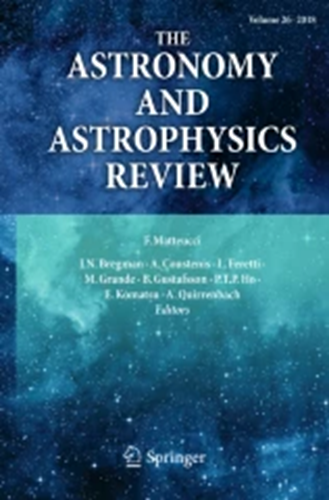银河系中心星暴Sgr B2的亚毫米成像
IF 26.5
1区 物理与天体物理
Q1 ASTRONOMY & ASTROPHYSICS
引用次数: 5
摘要
我们展示了用Herschel/SPIRE-FTS拍摄的Sgr B2复合体的168 arcmin^2光谱图像。我们检测到CO(高达J=12-11), H2O, [CI]492, 809 GHz和[NII] 205 um线的普遍辐射。我们还提供了用IRAM30m望远镜获得的SiO, N2H+, HCN和HCO+发射图。云环境主导发射的FIR(80%)、H2O 752 GHz(60%)、中焦CO(91%)和[CI](93%)亮度。该区域显示出非常广泛的[NII]发射(与24和70微米尘埃发射在空间上相关)。观测到的FIR光度暗示G_0~10^3。扩展的[CI]发射来自于中性气体中弥漫的n_H~10^3 cm-3组分。宇宙射线(CR)通量增强产生的高电离率将气体加热到Tk~40- 60k。中焦距CO排放来自于类似扩展但压力更大的气体组分(P_th~10^7 K cm-3)。SiO排放增强和CO-to- fir强度比高(>10^-3)的特定区域显示中焦度CO排放与冲击模型相容。与我们银河系盘中更安静的恒星形成云相比,一个主要的区别是Sgr B2中SiO和N2H+发射的扩展性质。这可以解释为云-云碰撞和恒星反馈引起的云级冲击的存在,以及高得多的CR电离率(>10^-15 s-1)导致过量的H3+和N2H+。因此,Sgr B2拥有比银河系盘面上恒星形成区域更极端的环境。作为星系外比较的常用模板,Sgr B2与像Arp 220这样的超亮红外星系有更多的相似之处,包括在[CI]/FIR和[NII]/FIR强度比上的“缺陷”,而不是像M82这样的纯星爆星系。然而,当望远镜无法分辨星系中这样的扩展区域时,它是扩展的云环境,而不是核心,作为一个有用的模板。本文章由计算机程序翻译,如有差异,请以英文原文为准。
Submillimeter imaging of the Galactic Center starburst Sgr B2
We present 168 arcmin^2 spectral images of the Sgr B2 complex taken with Herschel/SPIRE-FTS. We detect ubiquitous emission from CO (up to J=12-11), H2O, [CI]492, 809 GHz, and [NII] 205 um lines. We also present maps of the SiO, N2H+, HCN, and HCO+ emission obtained with the IRAM30m telescope. The cloud environment dominates the emitted FIR (80%), H2O 752 GHz (60 %) mid-J CO (91%), and [CI] (93 %) luminosity. The region shows very extended [NII] emission (spatially correlated with the 24 and 70 um dust emission). The observed FIR luminosities imply G_0~10^3. The extended [CI] emission arises from a pervasive component of neutral gas with n_H~10^3 cm-3. The high ionization rates, produced by enhanced cosmic-ray (CR) fluxes, drive the gas heating to Tk~40-60 K. The mid-J CO emission arises from a similarly extended but more pressurized gas component (P_th~10^7 K cm-3). Specific regions of enhanced SiO emission and high CO-to-FIR intensity ratios (>10^-3) show mid-J CO emission compatible with shock models. A major difference compared to more quiescent star-forming clouds in the disk of our Galaxy is the extended nature of the SiO and N2H+ emission in Sgr B2. This can be explained by the presence of cloud-scale shocks, induced by cloud-cloud collisions and stellar feedback, and the much higher CR ionization rate (>10^-15 s-1) leading to overabundant H3+ and N2H+. Hence, Sgr B2 hosts a more extreme environment than star-forming regions in the disk of the Galaxy. As a usual template for extragalactic comparisons, Sgr B2 shows more similarities to ultra luminous infrared galaxies such as Arp 220, including a "deficit" in the [CI]/FIR and [NII]/FIR intensity ratios, than to pure starburst galaxies such as M82. However, it is the extended cloud environment, rather than the cores, that serves as a useful template when telescopes do not resolve such extended regions in galaxies.
求助全文
通过发布文献求助,成功后即可免费获取论文全文。
去求助
来源期刊

The Astronomy and Astrophysics Review
地学天文-天文与天体物理
CiteScore
45.00
自引率
0.80%
发文量
7
期刊介绍:
The Astronomy and Astrophysics Review is a journal that covers all areas of astronomy and astrophysics. It includes subjects related to other fields such as laboratory or particle physics, cosmic ray physics, studies in the solar system, astrobiology, instrumentation, and computational and statistical methods with specific astronomical applications. The frequency of review articles depends on the level of activity in different areas. The journal focuses on publishing review articles that are scientifically rigorous and easily comprehensible. These articles serve as a valuable resource for scientists, students, researchers, and lecturers who want to explore new or unfamiliar fields. The journal is abstracted and indexed in various databases including the Astrophysics Data System (ADS), BFI List, CNKI, CNPIEC, Current Contents/Physical, Chemical and Earth Sciences, Dimensions, EBSCO Academic Search, EI Compendex, Japanese Science and Technology, and more.
 求助内容:
求助内容: 应助结果提醒方式:
应助结果提醒方式:


